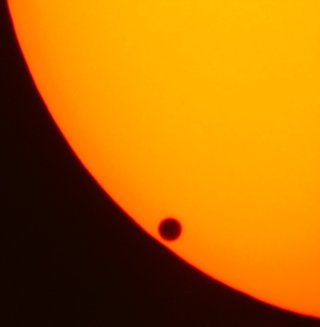A Transit of Venus is when Venus crosses the face of the
Sun as viewed from some vantage point - usually the Earth.
This is a special form of an eclipse - an Annular Eclipse.

The 2004 Transit of Venus
|
Transits of Venus are comparatively rare. There will be
one in June 2012, and there was one in June 2004. Here
are some of the dates:
| 1518-06-05 | 1526-06-02 |
| 1631-12-07 | 1639-12-04 | 113.5 years later |
| 1761-06-06 | 1769-06-03 | 129.5 years later |
| 1874-12-09 | 1882-12-06 | 113.5 years later |
| 2004-06-08 | 2012-06-06 | 129.5 years later |
| 2117-12-11 | 2125-12-08 | 113.5 years later |
| 2247-06-11 | 2255-06-09 | 129.5 years later |
|
As you can see, they come in pairs, eight years apart.
The 1631 transit was predicted by Johannes Kepler, but
he predicted a near miss for 1639. Jeremiah Horrocks
corrected the calculations and correctly predicted the
transit. He then became the first person in recorded
history to witness a transit of Venus.
The transits were once very important, as they provided
a method of computing the actual distance to the Sun. Until
then, only relative distances within the Solar System were
known. Transits were so important that various expeditions
were dispatched by the Royal Society to observe them. Captain
James Cook was sent to Tahiti to observe the 1769 transit,
and that was the voyage on which he discovered New Zealand,
the East coast of Australia, and many other things.
Here are some sites to find out more:
http://eclipse.gsfc.nasa.gov/transit/venus/Map2012-2.GIF
Contents
There were no headings
in the main text so there
is no table of contents.
| |
Links on this page
| |
Site hosted by
Colin and
Rachel Wright:
- Maths, Design, Juggling, Computing,
- Embroidery, Proof-reading,
- and other clever stuff.
|
|
 Suggest a change ( <--
What does this mean?) /
Send me email
Suggest a change ( <--
What does this mean?) /
Send me email
Front Page /
All pages by date /
Site overview /
Top of page


 Suggest a change ( <--
What does this mean?) /
Send me email
Suggest a change ( <--
What does this mean?) /
Send me email